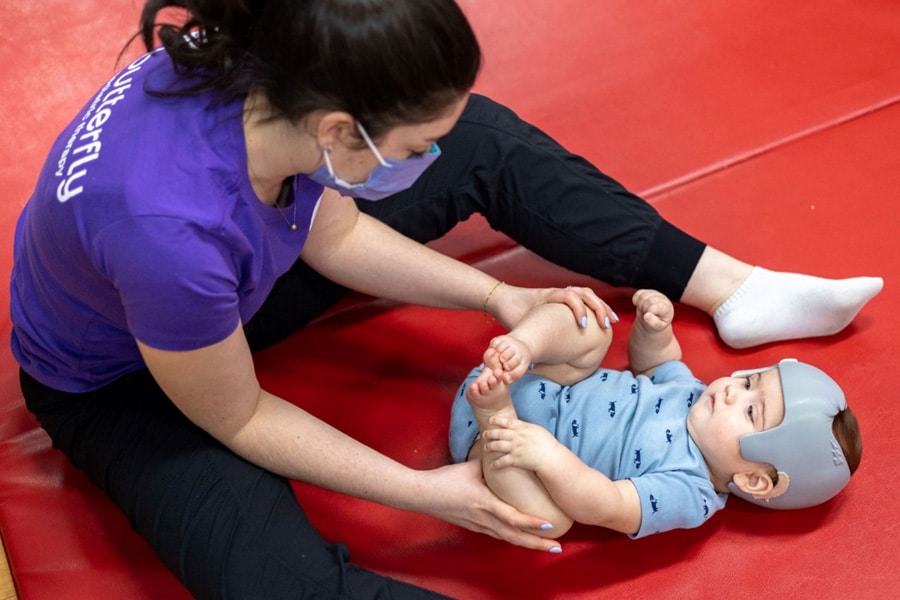As a parent, noticing that your baby consistently tilts their head to one side or has a flat spot on the back or side of their head can feel alarming. Two common but treatable conditions—torticollis (tight neck muscles) and plagiocephaly (flat head syndrome)—often go hand in hand.
The good news is that when caught early, pediatric physiotherapy can gently and effectively support your baby’s recovery and development. At the NJ Craniofacial Center, our experienced care team has helped hundreds of families address these concerns with personalized, evidence-based treatment plans.
What Are Plagiocephaly and Torticollis?
Plagiocephaly (Flat Head Syndrome)
This condition occurs when an infant develops a flat spot on the back or side of the head, usually due to repeated pressure in the same position during sleep or rest.
Torticollis (Twisted Neck)
Torticollis is caused by tightness or shortening of the neck muscles, often making it difficult for your baby to turn their head equally in both directions. Babies with torticollis often favor one side, which increases the risk of developing plagiocephaly.
When these conditions are addressed early—ideally within the first 4 months of life—physiotherapy can prevent long-term complications and support healthy development.
How Are Plagiocephaly and Torticollis Connected?
When a baby has torticollis, they tend to rest their head in the same position, leading to a flat spot. By improving neck mobility through physiotherapy, we reduce the risk or severity of plagiocephaly and help your baby achieve better symmetry and movement.
How Physiotherapy Helps
Pediatric physiotherapy focuses on gentle, hands-on techniques to:
- Correct head shape asymmetry
- Improve neck flexibility and strength
- Encourage balanced muscle use and proper posture
- Support developmental milestones like tummy time, rolling, and crawling
Key Physiotherapy Techniques for Plagiocephaly
1. Repositioning Therapy
- Alternate your baby’s head position during sleep and rest
- Change holding and carrying positions regularly
- Encourage tummy time while your baby is awake and supervised
2. Tummy Time Strategies
- Begin with 3–5 minute sessions, gradually increasing as tolerated
- Use toys, mirrors, or caregiver interaction to promote head turning
- Try chest-to-chest tummy time for comfort and bonding
3. Helmet Therapy (For Severe Cases)
If repositioning and exercises don’t improve head shape by 6 months, a cranial helmet may be recommended. Helmets gently guide skull growth to improve symmetry.
| Treatment | Best Timing | Purpose |
| Repositioning | Before 4 months | Pressure relief and symmetry |
| Tummy Time | Ongoing | Strengthen neck and shoulder muscles |
| Helmet Therapy | 4–12 months | Correct moderate-severe flattening |
Key Physiotherapy Techniques for Torticollis
1. Stretching Exercises
- Gentle tilting and rotation stretches to release tight neck muscles
- Daily exercises prescribed by your physiotherapist for home use
2. Strengthening Activities
- Encourage head turning with toys or caregiver voices
- Position stimuli on your baby’s non-preferred side
3. Supportive Holding and Feeding Positions
- Alternate sides during bottle-feeding or breastfeeding
- Hold your baby so they are encouraged to look in both directions
| Technique | Goal |
| Stretching | Increase flexibility and range of motion |
| Strengthening | Balance neck muscles |
| Positioning | Promote symmetrical development |
When Should You See a Physiotherapist?
Early intervention leads to the best results. Talk to your pediatrician or a pediatric physiotherapist if you notice:
- Your baby tilts or turns their head to only one side
- Difficulty turning their head in both directions
- A flat spot that’s not improving with repositioning
- Developmental delays like not lifting the head or rolling over on time
Long-Term Benefits of Physiotherapy for Infants
With early and consistent physiotherapy:
- Many babies avoid needing helmet therapy or surgery
- Proper neck alignment and posture are restored
- Delays in crawling, walking, or other milestones are reduced
- Long-term risks like chronic pain or spinal imbalance are minimized
At NJ Craniofacial Center, our pediatric specialists provide individualized treatment plans that empower families with at-home exercises, progress monitoring, and emotional support throughout their child’s journey.
Conclusion
Plagiocephaly and torticollis are common in infancy—but they don’t have to lead to long-term problems. With early diagnosis and the right pediatric physiotherapy, your baby can develop strong muscles, a healthy head shape, and reach their milestones on time.
At NJ Craniofacial Center, our compassionate team offers expert care for your child’s unique needs.
📞 Schedule a consultation today at Nj Craniofacial Center to learn how our pediatric specialists can help your baby grow strong and thrive.
Call us at (973) 326-9009 or visit njcraniofacialcenter.com to book your appointment.


